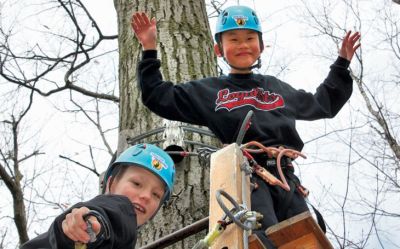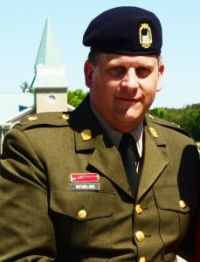Bright but underachieving? Always testing the limits? Possibly exhibiting the characteristics of or diagnosed with ADHD, ODD, LD or other learning challenges? Requiring more structure and resource than you can provide? Likable, charming and full of potential? Are you the only one who believes that he is capable of so much more? We have a place for him. Robert Land Academy is a not-for-profit military-themed boarding school helping boys in grades 5 through 12 to achieve their potential and be successful. (Est 1978)

Some students thrive in environments where they have lots of latitude to be independent and self-motivating. Others thrive in the opposite: an environment that is it structured and ordered, with very clear limits and recognizable boundaries. Robert Land Academy, truly, is for them. The daily routine is regimented, and discipline is enforced. The results, often, are astonishing. This is a school that prides itself on its ability to turn lives around, and that pride is well placed. Robert Land isn't for every student, but, of course, no school is. For students who require structure in order to succeed, the school can make a remarkable difference in a very short period of time.

Central to your child's school experience is the underlying curriculum taught in the classroom. "Curriculum" refers to both what is taught and how it's taught. When considering the different curricula outlined in the next few pages, keep in mind that few schools fall neatly into one category or another. Most schools' curricula comprise a blend of best practices drawn from multiple curriculum types. Having said that, most schools do have a general overall curriculum type. These are identified for each school on OurKids.net.
Primary Curriculum: TraditionalTraditional curricula tend to be very content-based and rooted in the core disciplines. It is a structured approach that involves the teacher delivering a unified curriculum through direct instruction. Uczniowie najpierw zdobywają wiedzę podstawową i teoretyczną, aby później stosować ją w praktyce. Students usually learn by observing and listening to their teacher, studying facts and concepts in textbooks, and completing both tests and written assignments - which challenge students to not only demonstrate their mastery of content but their ability to analyze and deconstruct it critically. Class discussions are also used to create critical dialogue around the content of the curriculum.
| Focus | Special needs |
|---|---|
| Military | Special needs , Troubled Teens |
| Flexible pacing style | offered |
|---|---|
| Subject-streaming (tracking) | |
| Multi-age classrooms as standard | |
| Ability-grouping (in-class) as common | |
| Frequent use of cyber-learning (at-their-own-pace) | |
| Regular guided independent study opportunities | |
| Differentiated assessment |
| Subject type | offered |
|---|---|
| Learning strategy and study counselling; habit formation | |
| Extra support and minor accommodations for children experiencing subclinical difficulties |
| Subject type | offered |
|---|---|
| Accommodations | |
| Modifications | |
| Extra support |
| Special needs | Accomodations
Formal adjustments are made to the delivery of lessons to help mitigate the learning difficulty or exceptionality. The underlying content and expectations remain unchanged with accommodations, however. (Example: allowing a student to write tests in a quieter room). | Modifications The underlying content and expectations are modified and/or simplified for the sake of the student. (Examples: allowing student to use a calculator on a test when other students can’t; allowing students to bring word-banks or “cheat sheets” into certain tests, etc) | Remediation Research-based therapeutic measures that target and ameliorate the underlying weakness. |
|---|---|---|---|
| Learning disabilities | |||
| ADHD (moderate to severe) | |||
| Dyslexia (Language-Based Learning Disability) | |||
| Auditory Processing Disorder (APD) | |||
| Dyscalculia | |||
| Dysgraphia | |||
| Language Processing Disorder | |||
| Nonverbal Learning Disorders (NLD) | |||
| Visual Perceptual/Visual Motor Deficit | |||
| Developmental | |||
| Autism | |||
| Asperger's Syndrome | |||
| Down syndrome | |||
| Intellectual disability | |||
| Behavioral and Emotional | |||
| Troubled behaviour / troubled teens | |||
| Clinical Depression | |||
| Suicidal thoughts | |||
| Drug and alcohol abuse | |||
| Oppositional Defiant Disorder (ODD) | |||
| Physical | |||
| Dyspraxia (Developmental Coordination Disorder) | |||
| Blindness | |||
| Deafness | |||
| Cystic Fibrosis | |||
| Multiple physical |
| Program | offered |
|---|---|
| Full-time gifted program (parallel to rest of school) | |
| Part-time gifted program (pull-out; parallel to rest of class) |
Curriculum delivery: Acceleration and enrichment (There is an equal emphasis on acceleration and enrichment.)
| Program | offered |
|---|---|
| Custom subject enrichment (special arrangement) | |
| Custom curriculum compacting (special arrangement) | |
| Guided independent study (custom gifted arrangement) | |
| Cyber-learning opportunities (custom gifted arrangement) | |
| Formalized peer coaching opportunities (specifically for gifted learners to coach others) | |
| Custom subject acceleration (special arrangement) | |
| Career exploration (custom gifted arrangement) | |
| Project-based learning (custom gifted arrangement) | |
| Mentorships (custom gifted arrangement) |
In grade Gr. 12, Robert Land Academy students perform an average of >2 hours of homework per night.
| 6 | 7 | 8 | 9 | 10 | 11 | 12 | |
|---|---|---|---|---|---|---|---|
| Robert Land Academy | 30 mins | 30 mins | 30 mins | 90 mins | 90 mins | 160 mins | 160 mins |
| Site Average | 39 mins | 51 mins | 52 mins | 71 mins | 75 mins | 104 mins | 112 mins |
This information is not currently available.
| Grades | Gender | Living Arrangement | Enrollment |
|---|---|---|---|
| Gr. 5 to Gr. 12 | Boys | Boarding School | 125 |
| Total enrollment | 125 |
| Average enrollment per grade | INF |
| Average class size | 10 to 16 |
| Gender | Boys |
| Grades | Gr. 5 to Gr. 12 |
| Boarding offered | Gr. 5 to Gr. 12 |
| % in boarding (total enrollment) | 100% |
| % of foreign students | 20% |
| # of nationalities attending school | 10 |
| Services | Offered |
|---|---|
| Career planning | |
| Internships | |
| Mentorship Program | |
| University counseling |
| Key Numbers | |
|---|---|
| Average graduating class size | 20 |

Robert Land Academy is a dynamic living and learning environment intended to resonate with the needs of adolescent males and encourage them to explore their potential.
Despite many changes since its founding in 1978, the Academy has stayed true to its central mission of serving boys and their families and helping them to steer a course to a productive adulthood and future.
The military theme has served the students well in providing the structure and accountability now so lacking in many educational environments and so desperately needed by so many young men. Central to our program has been the belief that encouraging boys to confront and overcome challenges is the only way to stimulate real emotional growth and intellectual development.
Respectfully Yours,
Kevin Wendling
Headmaster